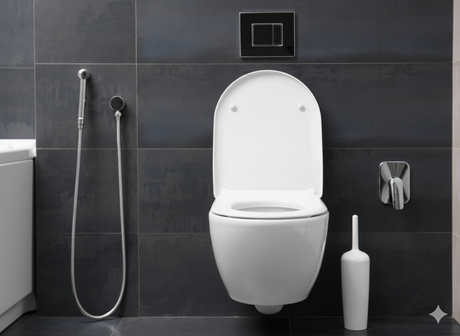Toilet issues may appear minor initially, but they can rapidly escalate into significant problems if not addressed promptly. Minor issues such as cracks, leaks or clogs can quickly escalate into significant water damage and expensive repairs. Drawing on many years of professional experience, I have identified six common issues that account for the majority of toilet bowl repair calls from homeowners. Some tasks are simple enough to be carried out by yourself, while others require the expertise of a professional. It is important to be aware of the differences between these two options in order to make informed decisions that can save both time and money.
Essential Tools for DIY Toilet Bowl Repair Success
Before tackling any toilet bowl repair, having the right tools on hand makes all the difference. Many issues can be solved quickly with a few essentials, but missing even one can turn a simple toilet repair into a stressful job. Here are the must-have items for your toolkit:
- Quality adjustable wrench
- Toilet auger
- Headlamp for hands-free visibility
- Bucket and old towels
- Rubber gloves that fit well
- Wax ring kit with bolts

Issue 1: Toilet Bowl Cracks and How to Fix Them
Not every crack means an immediate replacement or a major toilet bowl repair expense. Superficial surface lines, also known as crazing, are usually cosmetic. However, structural cracks are different—if your fingernail catches on the line or if water seeps through, it’s a clear sign of a problem. Hairline cracks can expand within days, turning into leaks that cause floor damage if left untreated.
Step-by-Step Crack Repair Methods That Work
- Clean the area with a degreasing agent, not standard bathroom cleaner.
- Apply a porcelain repair compound in thin layers and allow at least 48 hours to cure.
- Sand lightly with 220-grit paper and finish with polish for a smooth surface.
- For deep or spreading cracks, replacement is the only reliable solution. Attempting to patch these often leads to higher costs later, as structural damage cannot be permanently sealed.
Issue 2: Persistent Toilet Bowl Leaking Problems
Leaks are one of the most common reasons for a toilet repair call. To identify the source, start with a simple test: turn off the supply valve and mark the tank’s water level with tape. If the water level drops after two hours, you have an internal leak. If water collects around the base, the wax ring is likely failing. Internal leaks often come from worn flappers or seals, while external leaks typically result from a damaged wax ring.
Professional Toilet Repair Techniques for Leaks
- Remove the toilet carefully and only on a stable, warm day to make wax easier to work with.
- Clean away all old wax with a putty knife and mineral spirits before installing a new ring.
- Check the flange level and use shims if needed.
- Tighten bolts gradually with alternating turns to avoid stressing the porcelain.
Issue 3: Toilet Bowl Wobbling and Instability
A wobbling toilet is often ignored, but it can lead to costly floor or tile damage. Any side-to-side movement indicates a potential issue with the mounting bolts, deteriorated wax ring, or floor settlement. Addressing it early prevents more extensive toilet bowl repair work later.
Securing Your Toilet Bowl: 3 Proven Methods
- Tighten existing hardware if bolts are intact and corrosion-free.
- Replace old or rusted bolts and renew the wax ring at the same time.
- Correct floor irregularities with plastic shims—never use wood, as it absorbs moisture and deteriorates.
Issue 4: Toilet Bowl Staining and Discoloration
Stains from mineral buildup are common in areas with hard water and can make toilets appear permanently dirty. For effective toilet repair in these cases, a pumice stone works well to remove deposits without scratching the porcelain.
Preventing Future Toilet Bowl Staining Issues
- Perform weekly cleaning with appropriate products to reduce buildup.
- Conduct a monthly deep clean with pumice stone where needed.
- Consider installing a water softener if you face persistent hard water issues, which not only reduces stains but also prolongs the life of plumbing fixtures.
Issue 5: Toilet Bowl Water Level Problems
Low water levels reduce flushing efficiency and may allow sewer gases to escape. Often, the cause is a warped or worn flapper, which drains water slowly. Replacing the flapper resolves most cases, while float adjustments fix the remainder.
Solving High Water Level and Overflow Issues
High water levels waste resources and risk overflow damage. Start by adjusting the float mechanism in small increments. If the problem persists, replacing the fill valve assembly is the most reliable solution. Regular maintenance of these parts ensures smoother long-term toilet bowl repair results.
Issue 6: Strange Noises During Toilet Operation
Unusual sounds often indicate underlying issues. Gurgling usually points to a partial blockage, while whistling suggests a worn fill valve, and banging signals water hammer. Running water noises typically mean problems with the flapper chain or seal.
Eliminating Unusual Toilet Repair Noise Problems
- Use a toilet auger to clear partial blockages.
- Replace aging fill valves to eliminate whistling.
- Secure pipes or install a water hammer arrestor to fix banging.
- Adjust or replace the flapper chain to stop continuous running sounds.
When to Call Professionals
Some toilet bowl repair tasks are suitable for DIY, but certain situations require professional attention to avoid costly damage. Call a licensed plumber if you encounter:
- Major structural cracks in the toilet bowl or tank.
- Continuous leaks that persist after replacing flappers, fill valves, or wax rings.
- Sewer line blockages or gurgling sounds linked to ventilation issues.
- Significant floor damage or unstable toilet installation.
- Repeated failures after multiple DIY repair attempts.

Preventing Future Emergencies
While knowing how to fix problems is important, prevention is the real key to avoiding costly toilet bowl repair emergencies. A few simple habits can stop small issues from becoming major failures:
- Do monthly checks: Inspect mounting bolts, test toilet stability, listen for unusual sounds, and look for signs of leaks. A five-minute routine prevents hours of emergency repair.
- Replace parts proactively: Wax rings should be replaced every 5–7 years, while internal mechanisms such as fill valves and flappers generally last 7–10 years depending on water quality and usage.
- Prioritize maintenance: Don’t wait until the toilet breaks to think about it. Regular upkeep saves money and ensures reliable performance.
Final Thoughts on DIY Toilet Bowl Repair
Twenty years of renovation work taught me that successful toilet bowl repair depends more on proper diagnosis than advanced skills. Understanding what you're dealing with prevents expensive mistakes. Most toilet repair projects take 1-3 hours with proper preparation. Having correct tools and replacement parts ready makes the difference between smooth repairs and frustrated phone calls to professionals. Remember: patience and preparation beat rushing every time. Take time to understand the problem, gather proper tools, and work systematically through solutions.
FAQs
What Causes Most Toilet Bowl Repair Problems?
Wax ring failure accounts for about 40% of issues I handle, followed by loose bolts and worn internal components. Regular maintenance prevents most problems.
Can I Fix Toilet Bowl Cracks Myself?
Surface cracks yes, structural cracks no. If you can catch your fingernail in the crack or see water seepage, replacement is safer than repair attempts.
How Often Should I Perform Toilet Maintenance?
Monthly visual inspections, annual component checks, and replace wax rings every 5-7 years. More frequent in hard water areas.
How Much Water Does a Leaking Toilet Waste?
Continuous running can waste 200+ gallons daily. Even small leaks add up quickly on water bills. Fix immediately to prevent waste and damage.








